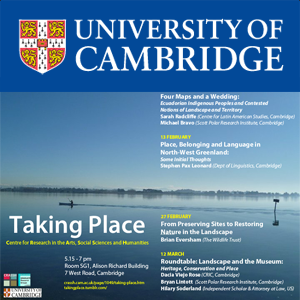Taking Place - 14 May 2014 - Eyeopener: Geographies of Light and Shadow, Near and Far
Duration: 47 mins 14 secs
Share this media item:
Embed this media item:
Embed this media item:
About this item

| Description: |
John Wylie (University of Exeter)
Abstract What can the practice of en plein air landscape drawing bring to cross-disciplinary understandings of spatiality, materiality and self-world relations? To address this question, this presentation will draw upon a year-long visual arts-based collaboration between John Wylie and a contemporary fine artist, Catrin Webster. The collaboration has involved a primary learning process, ongoing professional practice, and extended conceptual conversation. After setting the scene for this collaboration, the talk will focus on the embodied skills and habits of visual and spatial apprehension which the incorporation of painterly practice affords. The exemplars of painting and drawing will also be used to elucidate a developing sense that distance and dislocation are distinctive elements of landscape as a mode of spatial experience, imagination and presentation. |
|---|
| Created: | 2014-05-19 09:08 |
|---|---|
| Collection: | Taking Place Seminar |
| Publisher: | University of Cambridge |
| Copyright: | Glenn Jobson |
| Language: | eng (English) |
| Keywords: | CRASSH; Taking Place; |
| Abstract: | John Wylie (University of Exeter)
Abstract What can the practice of en plein air landscape drawing bring to cross-disciplinary understandings of spatiality, materiality and self-world relations? To address this question, this presentation will draw upon a year-long visual arts-based collaboration between John Wylie and a contemporary fine artist, Catrin Webster. The collaboration has involved a primary learning process, ongoing professional practice, and extended conceptual conversation. After setting the scene for this collaboration, the talk will focus on the embodied skills and habits of visual and spatial apprehension which the incorporation of painterly practice affords. The exemplars of painting and drawing will also be used to elucidate a developing sense that distance and dislocation are distinctive elements of landscape as a mode of spatial experience, imagination and presentation. |
|---|---|

